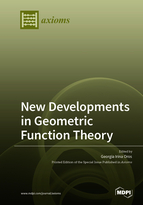New Developments in Geometric Function Theory
A special issue of Axioms (ISSN 2075-1680). This special issue belongs to the section "Mathematical Analysis".
Deadline for manuscript submissions: closed (31 October 2022) | Viewed by 31072
Please contact the Guest Editor or the Journal Editor ([email protected]) for any queries about the scope, discount, submission procedure and publication process.
Special Issue Editor
Interests: special classes of univalent functions; differential subordinations and superordinations; differential operators; integral operators; differential–integral operators
Special Issues, Collections and Topics in MDPI journals
Special Issue Information
Dear Colleagues,
This special issue aims to gather the latest developments in the research concerning complex-valued functions from Geometric Function Theory point of view. Contributions are expected regarding any aspects of subordination and superordination results, different types of operators specific to the research in this field, special functions connected to univalent functions’ theory. Hopefully, new approaches would emerge regarding the introduction and study of special classes of univalent functions using operators and the classical theories of differential subordination and superordination as well as the newer adapted theories of strong differential subordination and superordination and fuzzy differential subordination and superordination. Authors are invited to submit their latest results related to analytic functions in all their variety and also related to their applications in other fields of research. Quantum calculus and its applications in Geometric Function Theory is also expected to provide interesting outcome. Presentation of results obtained by using any other techniques which can be applied in the field of complex analysis and its applications are welcome.
This special issue devoted especially to complex analysis is proposed as a mean to find new approaches for Geometric Function Theory which to inspire further development of this field.
Prof. Dr. Georgia Irina Oros
Guest Editor
Manuscript Submission Information
Manuscripts should be submitted online at www.mdpi.com by registering and logging in to this website. Once you are registered, click here to go to the submission form. Manuscripts can be submitted until the deadline. All submissions that pass pre-check are peer-reviewed. Accepted papers will be published continuously in the journal (as soon as accepted) and will be listed together on the special issue website. Research articles, review articles as well as short communications are invited. For planned papers, a title and short abstract (about 100 words) can be sent to the Editorial Office for announcement on this website.
Submitted manuscripts should not have been published previously, nor be under consideration for publication elsewhere (except conference proceedings papers). All manuscripts are thoroughly refereed through a single-blind peer-review process. A guide for authors and other relevant information for submission of manuscripts is available on the Instructions for Authors page. Axioms is an international peer-reviewed open access monthly journal published by MDPI.
Please visit the Instructions for Authors page before submitting a manuscript. The Article Processing Charge (APC) for publication in this open access journal is 2400 CHF (Swiss Francs). Submitted papers should be well formatted and use good English. Authors may use MDPI's English editing service prior to publication or during author revisions.
Keywords
- analytic function
- univalent function
- harmonic function
- differential subordination
- differential superordination
- differential operator
- integral operator
- special functions
Benefits of Publishing in a Special Issue
- Ease of navigation: Grouping papers by topic helps scholars navigate broad scope journals more efficiently.
- Greater discoverability: Special Issues support the reach and impact of scientific research. Articles in Special Issues are more discoverable and cited more frequently.
- Expansion of research network: Special Issues facilitate connections among authors, fostering scientific collaborations.
- External promotion: Articles in Special Issues are often promoted through the journal's social media, increasing their visibility.
- e-Book format: Special Issues with more than 10 articles can be published as dedicated e-books, ensuring wide and rapid dissemination.
Further information on MDPI's Special Issue polices can be found here.
Related Special Issues
- New Developments in Geometric Function Theory II in Axioms (15 articles)
- New Developments in Geometric Function Theory, 3rd Edition in Axioms (4 articles)





